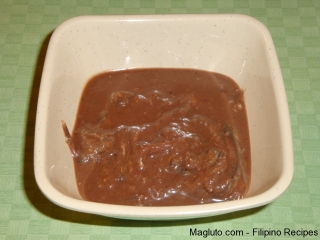Ingredients:
Use only good fresh fish (anchovies are preffered).
How to cook:
1. Wash the fish thoroughly with clean fresh water.
2. Mix the fish with clean pure salt.
( 1 part salt to 3 parts fish ) by measure
( 2 parts salt to 7 parts fish) by weight
3. Place the fish in fly proof, clean containers with a minimum.
4. Store the bagoong in a clean warm place which has a minimum of circulating air.
5. When the proper arm and body have developed in the product drain off the patis and grind the residual bagoong.
6. Strain patis and pack in clean container.
Wikipedia:
Bagoong monamon, bagoong monamon-dilis, or simply bagoong and bugguong munamon in Ilocano, is a common ingredient used in the Philippines and particularly in Northern Ilocano cuisine. It is made by fermenting salted anchovies which is not designed, nor customarily used for immediate consumption since it is completely raw. Therefore it is used as a cooking ingredient, upon when it is cooked alone, it can be used as an accompaniment to traditional food dishes. To most Westerners unfamiliar with this condiment, the smell can be extremely repulsive. Bagoong is however, an essential ingredient in many curries and sauces.
This bagoong is smoother than bagoong terong, however, they are similar in flavor. The odor is unique and smells strongly of fish. Fish sauce, common throughout Southeast Asian cuisine, is a by-product of the bagoong process. Known as patis, it is distinguished as the clear refined layer floating on the thicker bagoong, itself. Patis and bagoong can be interchanged in recipes, depending on personal taste and preference.
Bagoong is used as a flavor enhancing agent, in the place of salt, soy sauce, or monosodium glutamate. It is used fish stocks that are the base to many Ilocano dishes, like pinakbet, or as a dressing to greens as a dish called kinilnat or ensalada. Bagoong is also used as a condiment, in many cases, a dipping sauce for chicharon, green and ripe mangoes, or hard boiled eggs.
It is similar in taste and smell to that of anchovy paste.
In other areas of the Philippines, this type of bagoong can be named for the locale they came fro, eg; bagoong balayan (which is produced in the coastal town of Balayan in the Province of Batangas).

I just wanted to stop for a moment and tell you how much I enjoy your blog. It’s really been an eye-opener to see how sites like yours can provide such great info and thrive on the web. Congrats on your success and it’s nice to see your hard work paying off.
I have to admit that my stomach was grumbling as I looked this over. I can’t wait to try this out. Thanks so much for sharing